3.6: Carbon-Oxygen Double Bonds
- Page ID
- 189766
The largest class of oxygen-containing molecules is carbonyl compounds, which contain C=O bonds. A C=O stretch is normally easy to find in an IR spectrum, because it is very strong and shows up in a part of the spectrum that isn't cluttered with other peaks. Examples of carbonyl compounds include 2-octanone, a ketone, and butanal, an aldehyde. In an aldehyde, the carbonyl is at the end of a chain, with a hydrogen attached to the carbonyl carbon.

If you look at the IR spectrum of 2-octanone:
- there are sp3 C-H stretching and CH2 bending modes at 2900 and 1500 cm-1.
- there is a very strong peak around 1700 cm-1.

Source: SDBSWeb : http://riodb01.ibase.aist.go.jp/sdbs/ (National Institute of Advanced Industrial Science and Technology of Japan, 14 July 2008)
Even though there is just one C=O bond, the carbonyl stretch is often the strongest peak in the spectrum. That makes carbonyl compounds easy to identify by IR spectroscopy.
If you look at the IR spectrum of butanal:
- there are sp3 C-H stretching and CH2 bending modes at 2900 and 1500 cm-1.
- there is a very strong C=O peak around 1700 cm-1.
- there is a pair of medium peaks around 2700 and 2800 cm-1. This is the aldehyde C-H stretching mode.

Source: SDBSWeb : http://riodb01.ibase.aist.go.jp/sdbs/ (National Institute of Advanced Industrial Science and Technology of Japan, 14 July 2008)
The aldehyde C-H bond absorbs at two frequencies because it can vibrate in phase with the C=O bond (a symmetric stretch) and out of phase with the C=O bond (an asymmetric stretch), and these vibrations are of different energies. The probability of the symmetric stretch and the asymmetric stretch are about equal, so the two peaks are always about the same size. This unusual C-H peak can often be used to distinguish between an aldehyde and a ketone.


